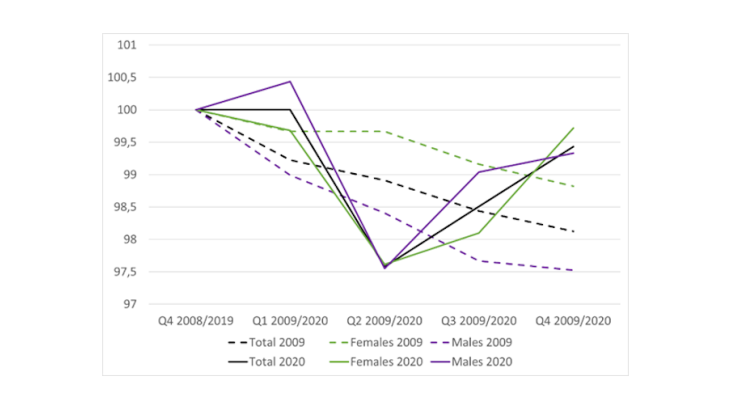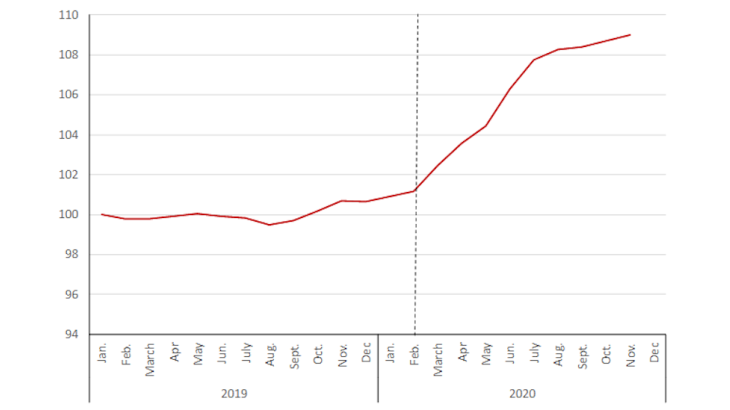In March 2020, the complete stoppage of activity to combat the pandemic triggered a highly atypical economic crisis, especially with regard to the labour market. In France, unlike in the Great Recession of 2008, there was very little difference in the evolution of unemployment and employment rates for men and women (Chart 1), even though the 2020 crisis primarily hit more “female” sectors such as services, and not industry as in 2008. This phenomenon can be explained by several factors:
- In the spring of 2020, due to the gender distribution of jobs, women found themselves on the front line in combating the virus. Health care jobs are primarily female: the majority of nurses are women, gender parity has almost been reached among doctors, and carers and home helpers are predominantly female. Other highly feminised occupations were also highly exposed, such as supermarket cashiers or cleaners who continued their activities at a time of major uncertainty over the illness.
- The widespread roll-out of the short-time work scheme, its adaptation to cover childcare, and the major support given to firms that were forced to close all helped to avert massive job losses and prevent large numbers of women from leaving the labour market, as occurred in the United States, South Korea and Japan (Djankov et al. 2020). The reopening of schools and childcare facilities after the spring 2020 lockdown also made it easier for mothers to (tele)work.
A major shift in women’s professional and private lives
For those women carrying out jobs deemed essential, one of the positive consequences of the health crisis has been the increased recognition and value given to their roles. The downside, however, is that they have been actively exposed to the virus and to the correlated fear of transmitting it to their families or to the vulnerable people they encounter in their work. For other women, the widespread switch to teleworking for those jobs that are eligible, and the massive use of the short-time work scheme – in particular during the first lockdown from March to May 2020 – have prompted a major shift in the organisation of labour and in their work-life balance.
Initially, working mothers may have struggled to cope with both teleworking and household chores. Albouy and Legleye (2020) have shown that mothers shouldered more of the burden of homeschooling than fathers, while at the same time continuing to do their usual unpaid chores, which also increased as a result of families being stuck at home (meals, food shopping, housework). Data collected by the OECD show that, well before the pandemic, mothers already performed the vast majority of household chores and childcare. Indeed, in developed countries, women spend two hours more than men each day on these tasks. The most significant item is childcare, with women devoting an average of 35 minutes a day to this task, more than double the amount spent by men (15 minutes per day). Mothers are also twice as likely as men to give up work to look after their children.
The positive side of the lockdowns and curfews is that many partners have now realised how big a burden domestic tasks are, and how difficult it is to combine them with a professional life. In the longer term, regular teleworking could lead to a better work-life balance and a fairer distribution of household chores within couples (Hupkau and Petrongolo, 2020).
Women and precarity during the Covid-19 pandemic
Despite the numerous public aid schemes put in place, the restrictions introduced to combat the pandemic have increased the number of people who are economically vulnerable. According to data from the Caisses d’allocations familiales (French family benefits office), the number of households claiming the revenu de solidarité active (RSA or income support) increased by 9% after the introduction of the lockdown and has since stabilised at this level (Chart 2). Among those in difficulty, income data from the OECD show that women are on average worse-off financially than men, especially those who are single parents (they accounted for 18% of overindebted households in 2020). The current crisis has exacerbated this situation. The closure of schools and childcare facilities in the spring of 2020 forced women to look after their children during the day, often at the expense of their job and income. Restrictions on contact with the elderly, who could have provided help, also led to women exiting the labour market or prompted a sharp fall in their income (Givord and Silhol 2020). Women are also generally the main caregivers for adult relatives who are unable to cope on their own. During the pandemic, many women have had to combine their jobs with additional family care responsibilities, limiting their availability in the labour market.

